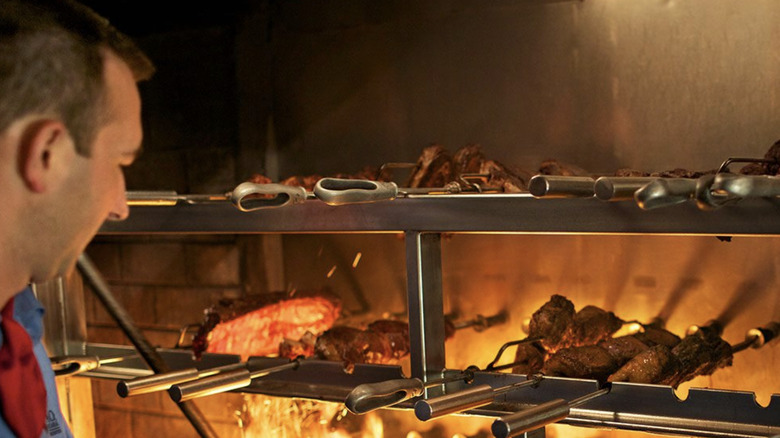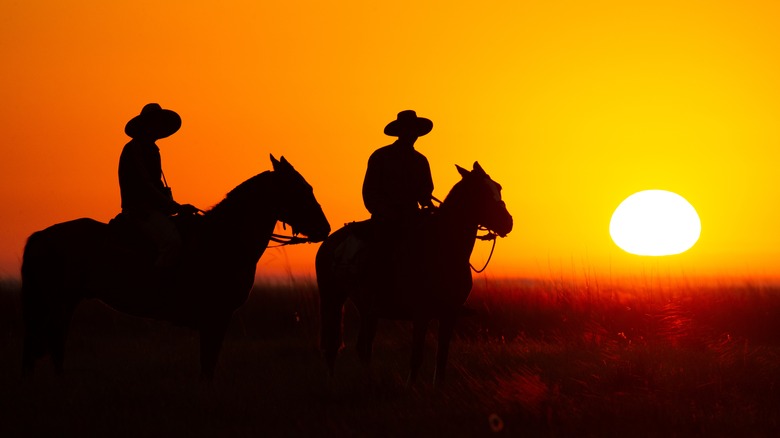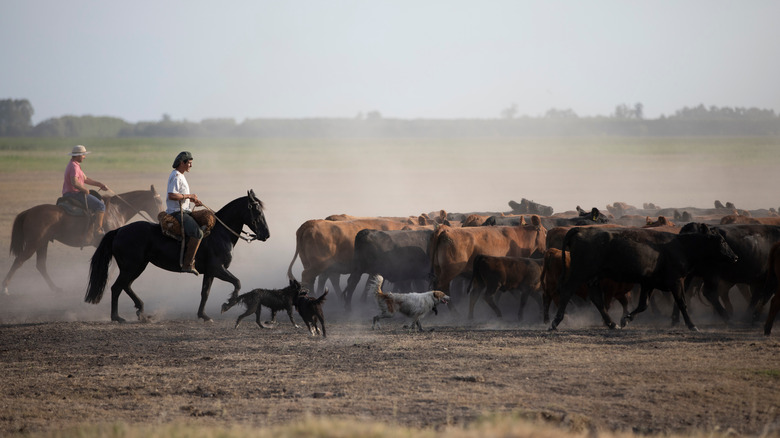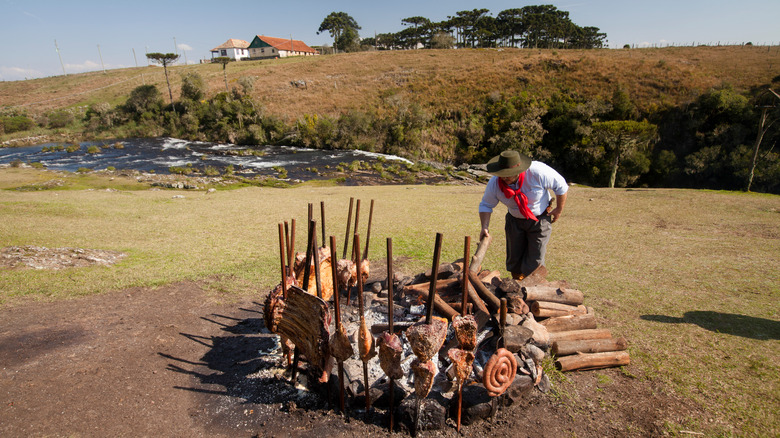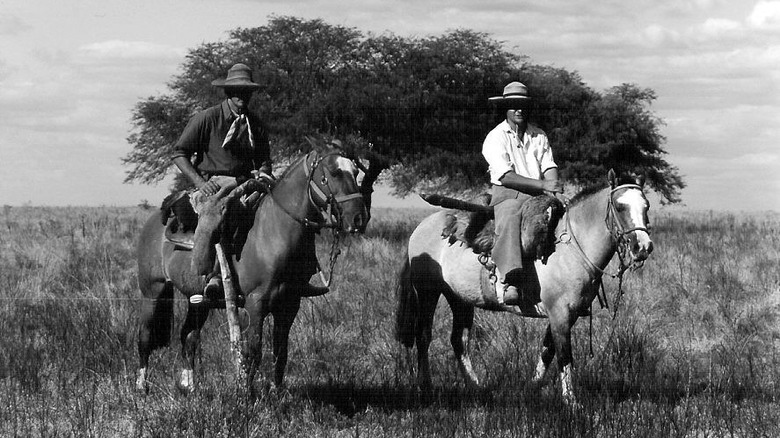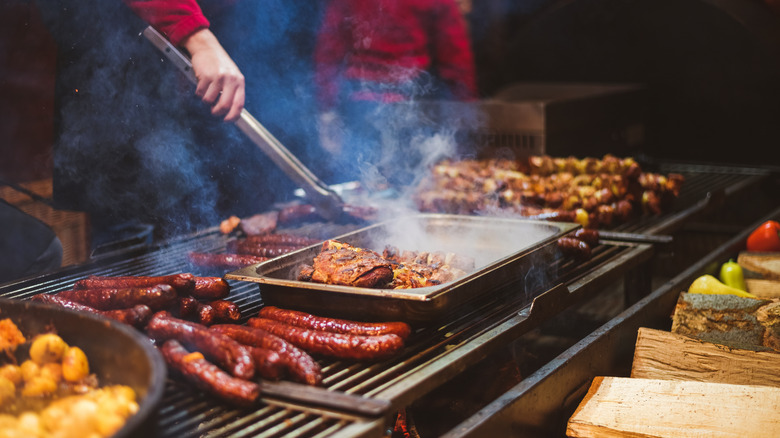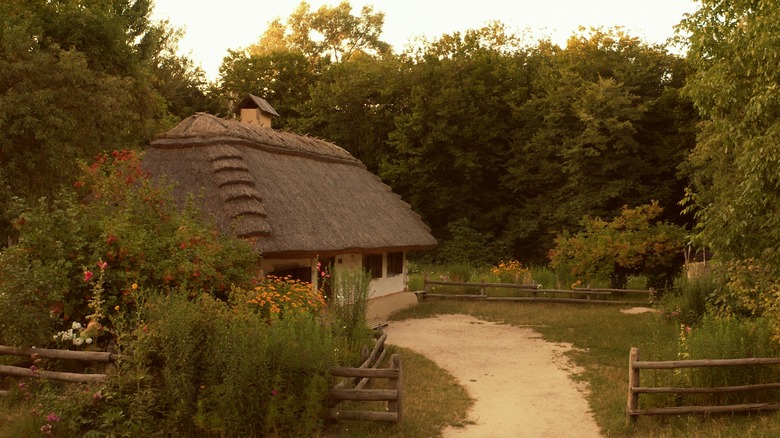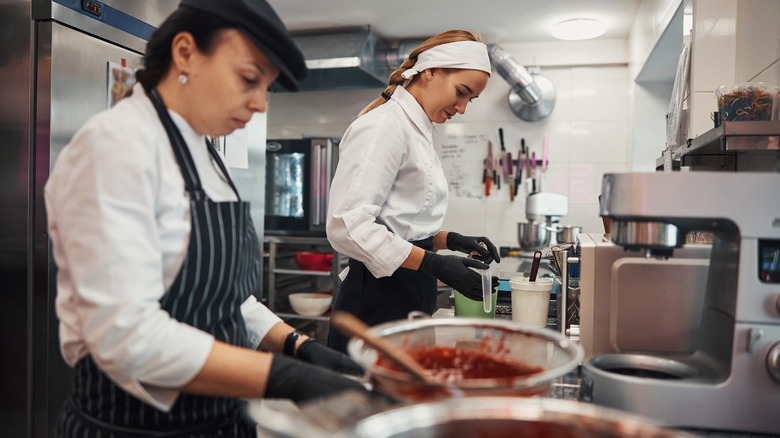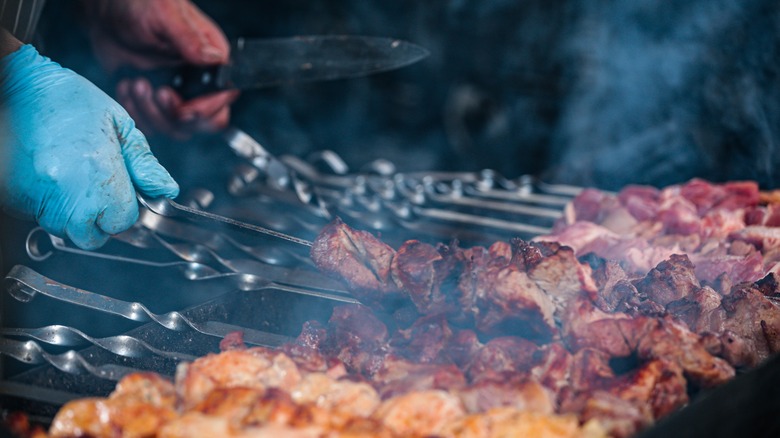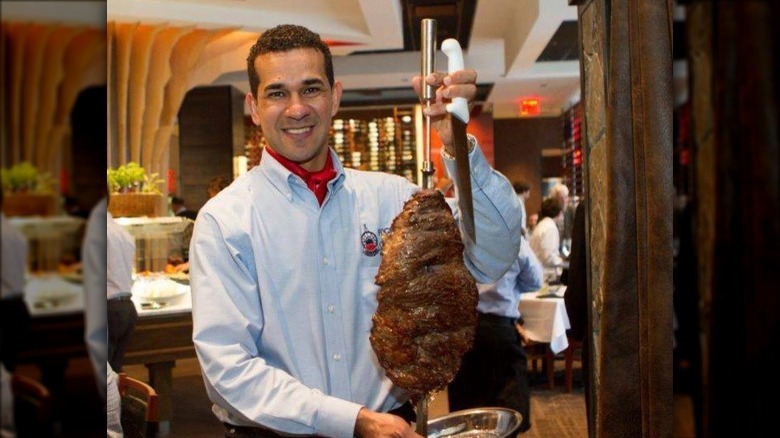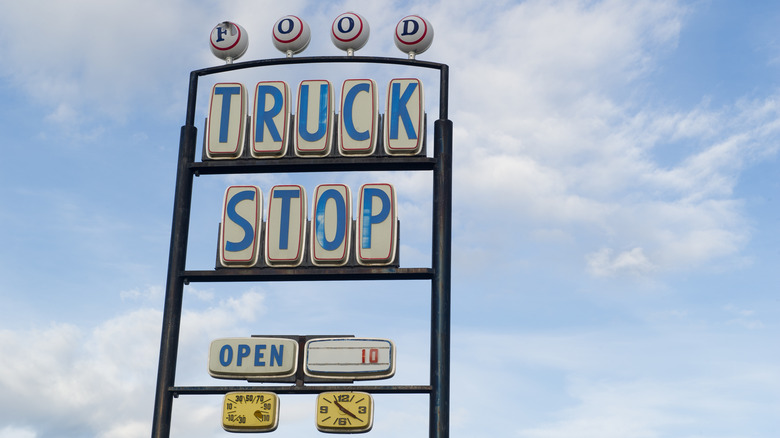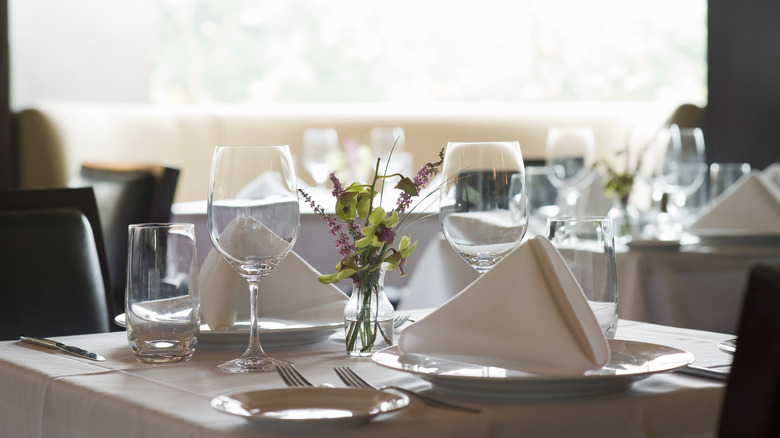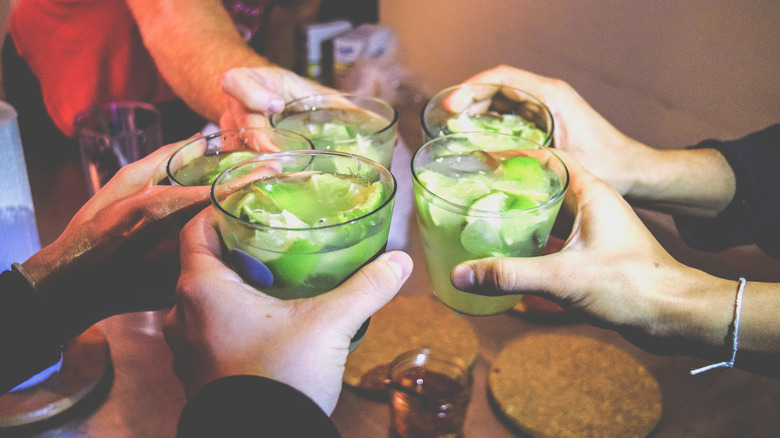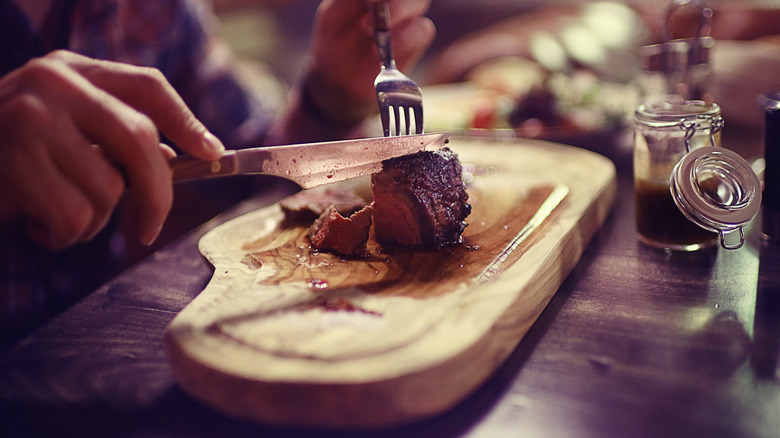The First Ever Fogo De Chão & What It Was Like To Eat There
How did a distinctly Brazilian steakhouse break into the U.S. market and find success to rival the best American barbecue restaurants? Fogo De Chão proved that there was an appetite for Brazilian barbecue in the States despite the centuries of tradition behind its American counterpart. With no menu and a fixed price, diners can choose from a wide variety of mouth-watering meats brought directly to their tables on skewers by wandering waiters. This unique style of service, along with the upscale setting, all-you-can-eat salad bar, and traditional Brazilian uniforms worn by the wait staff, has made Fogo De Chão a distinctive dining experience for Americans despite the plethora of other barbecue options to choose from. Since the first restaurant opened in 1979, the chain has expanded to more than 60 restaurants across Brazil, the U.S., Mexico, and the Middle East, with plans to move into Canada.
For those who may think Fogo De Chão is just another example of a shamelessly Americanized version of an authentic cuisine like tacos or sushi, the origins of the restaurant will come as a surprise. Founded by two sets of brothers in southern Brazil in the late 1970s, it is deeply rooted in the culture and traditions of its country of origin and didn't move stateside for nearly 20 years. Keep reading to discover what it was like to eat at the first ever Fogo De Chão.
It all started in southern Brazil
The first restaurant opened in 1979 in Porto Alegre, the capital city of the southernmost state in Brazil, Rio Grande do Sul. It was carefully modeled off the region's culture, which was shaped by gaúchos, the South American equivalent of cowboys. Gaúchos roamed on horseback, herding cattle throughout Uruguay, Argentina, and southern Brazil in the 18th and 19th centuries. People who live and operate farms in these areas still proudly identify with this ancestry and call themselves gaúchos.
The first Fogo De Chão was not only a celebration of the way the gaúchos cooked their meat over an open flame but also of their style of hospitality and dress. The Fogo chefs at the first restaurant were trained in the traditional gaúcho manner, while the wait staff dressed in traditional loose-fitting pants called bombachas with wide belts and red bandanas around their necks. Diners at many Fogo establishments throughout the world will still see these uniforms today.
The founders were two sets of brothers who grew up on neighboring ranches
Arri and Jair Coser founded the restaurant with Jorge and Aleixo Ongaratto. Both sets of brothers had grown up on gaúcho ranches in Rio Grande do Sul just miles from each other, but didn't cross paths until they were all working as busboys a thousand miles away in Rio de Janeiro. The Cosers received formal training in the gaúcho style of barbecuing (called churrasco) in São Paulo in the 1970s, where they honed their cooking skills and started dreaming up the concept for Fogo De Chão.
Arri Coser that he knew he wanted to open his own restaurant since the age of 14 when he was selling juice outside a São Paulo churrascaria. Determined to get a head start, he went out of his way to learn management skills from his superiors. As he told the Journal da Gazeta (per our translation), "Every day, I was the last one out," he remembered. "I served beer to the restaurant owners at the end of the day and listened to everything they said. That's how I learned what it's like to manage a churrascaria." When he returned to Rio Grande do Sul to start his own steakhouse, he went into business with his brother and the Ongarattos to purchase the building that became the first Fogo De Chão.
The concept was steeped in tradition
The first Fogo was all about fostering the traditional style of churrasco. Since the restaurant was located at the epicenter of gaúcho culture and the founders had grown up cooking in the traditional churrasco style, there was no skimping on authenticity. Many diners at the first restaurant in Porto Alegre would have associated churrasco with gatherings such as birthdays, weddings, and neighborhood get-togethers centered around an open fire as the meat slowly roasted over the flames. Traditionally, men would slaughter, salt, and roast the meat before delivering it to each table.
Churrasco is most commonly made with beef due to the tradition of cattle ranching in the southern region of Brazil, but it also includes a range of other meats such as sausage and chicken. Today, you can even buy fish at some Fogo restaurants. The first establishment adopted the distinctive gaúcho roasting method that combines open flames with charcoal, and the experience of dining there would no doubt have conjured happy memories for many of the local patrons who associated churrasco with joyful community gatherings.
The Coser brothers were drawing on family history
The brothers not only grew up in the Serra Gaúcha mountains of Rio Grande do Sul, but they also came from a ranching family. The region has an extensive history of cattle farming by Italian and German settlers, and Arri and Jair grew up working on the family's land alongside their six brothers and walking five kilometers to get to school. It was on the farm that they learned to cook in the traditional churrasco style, which they brought with them to the coastal cities of Rio de Janeiro and São Paulo when they left home to work in the restaurant industry.
This combination of the passed-down family methods of cooking churrasco and their experiences working in major restaurants informed the first Fogo De Chão. Churrasco for them was a deeply personal way of life that went back generations, and it's no wonder that when they decided to open a churrascaria, they did so in their home state of Rio Grande do Sul where it all began.
They were also trying to escape their past
As challenging as it is to work in the restaurant industry, working on a ranch is harder, at least according to Jair Coser. Speaking to the Dallas Morning News in 2011, he said that the first Fogo De Chão was a gamble that he was determined to win. "I didn't want to go back on the farm," he remembered. "I said, 'OK, [the restaurant] is hard, but there is worse.'" His brother Arri had left the family farm as early as age 12 to work on delivery trucks and went into the restaurant industry in São Paulo at the age of 14.
Both Coser brothers were motivated to leave farming in the past and worked hard to earn enough money from their various restaurant jobs to open their own establishment. They poured their hearts and souls (and financial reserves) into the first Fogo De Chão, hoping it would become their way to escape returning to the family business.
The building was a wooden shed with a straw roof
Fogo de Chão is known for its upscale setting and decor, but the first restaurant was nothing more than a wooden structure with a straw roof. The building in Porto Alegre had been updated by the previous owners to function as a café, but the site was far from the fancy establishments with cavernous dining rooms and polished furnishings that patrons of the steakhouse recognize today.
Having worked for years from the ground up in the restaurant industry, Arri Coser was not in a position to purchase anything more lavish, which was, at least in part, why he turned to his brother and the Ongarattos to chip into the business. He even borrowed money from his father, who gave him his life savings and the warning that if he lost it, he shouldn't bother coming home. What the first restaurant lacked in grandeur, however, it more than made up for in ambiance and cuisine, and it wasn't long before the founders' sacrifices paid off.
The employees rotated stations every week
The brothers were dedicated to turning their restaurant into a success. Having worked in steakhouses in the major cities of São Paulo and Rio de Janeiro for years, they were well-versed in cooking and waiting tables in addition to their business acumen, and this broad understanding was passed on to their employees. One of the rules at the first restaurant was that all members of staff be trained in each area of service.
Every week, employees switched stations, rotating between the steakhouse, working as kitchen support staff, serving tables, and manning the cash register. This helped create a harmonious working environment and further deepened their connection to the traditional style of gaúcho hospitality in which cooks would serve their food directly to patrons. These days, the gaúcho chefs may not be washing dishes, but the restaurant estimates that they walk about six miles each night to deliver sizzling meat from the grill to the guests' tables.
Meat was the focus
The salad bars at modern Fogo De Chão restaurants are legendary, but the concept behind the first restaurant was all about barbecued meat, grilled to perfection. Traditional gaúcho gatherings would often feature side dishes made by women and children, but Fogo was centered on the meat from day one. And while you might think that the spread would include a little barbecue sauce on the side at a bare minimum, traditional churrasco is rarely seasoned with anything other than salt.
According to Chef Evandro Caregnato, culinary director for the rival churrascaria chain Texas de Brazil and author of "Churrasco — Grilling the Brazilian Way," the unique appeal of Brazilian steakhouses is their variety and simplicity. On the one hand, you can sample multiple types of meat in one sitting, while on the other, the salt-only seasoning appeals to diners with pickier palates. The first Fogo De Chão leaned into the purest form of churrasco, based on the founder's extensive gaúcho family history and restaurant training.
Menus were not a part of the dining experience
From the beginning, the founders chose to model their restaurant on the rodízio (meaning "making the rounds") style of churrasco, which involves the wait staff ferrying skewers directly from the grill to the dining room, stopping at each table to offer the particular cut of meat to patrons. If the diner doesn't like what they see, they need only wait for the next member of staff to pass with a different type of meat. The history of rodízio is murky, but one of the most popular accounts tells of a server in the 1930s who brought a churrasco order to the wrong guest. Far from being irritated, the guest sampled the meat and decided they liked it. As this story illustrates, rodízio is all about variety and instant gratification in which diners aren't forced to choose one item off of a menu and can take advantage of whatever they see.
The founders of Fogo de Chão opted for this method, meaning that none of the guests in the first restaurant picked their meats off of a menu. Instead, like many Fogo diners today, they would have simply decided in the moment whether a certain cut of meat looked tasty as the server approached their table. These days, some Fogo restaurants offer appetizers and entrées in addition to their fixed, all-you-can-eat option, but at the first establishment, there was a single, all-inclusive price, not a menu.
It was part of a trend sweeping the country in the '70s
Rodízios had been a popular form of churrasco in southern Brazil since at least the 1930s, but you can thank truck drivers for paving the way for the first Fogo De Chão, at least indirectly. In the mid-20th century, the Brazilian government began pouring money into its infrastructure in what the president dubbed "Fifty Years in Five," referring to what he hoped would be five decades of progress within five years. Part of this push involved a rapid expansion of the highway system. Truckers began ferrying goods from one part of the country to the other, and inevitably needed places to eat. Rodízios proved to be the perfect solution for these busy drivers who wanted something quick and affordable to fill their stomachs without having to wait for a made-to-order meal.
In time, the appeal of these establishments grew and spilled over into the culinary industry more broadly. Rodízio-style restaurants cropped up in major cities throughout the country, and by the late 1970s, Fogo De Chão had joined the trend, bringing with it an important innovation: exclusivity.
Diners were likely surprised by how fancy it was
The traditional rodizío style of dining was far from the upscale experience that patrons of Fogo De Chão have come to expect from the restaurant. Due to their popularity as roadside food for truckers, they were usually humble establishments, and some were little more than a fire pit with a few tables scattered around. There were many rodízios before Fogo De Chão, but the Cosers and Ongarattos found their niche in the market by turning the traditionally rustic, informal rodízio dining experience into a high-end night out that was more than just a pit stop for hungry travelers.
In addition to dressing the serving staff in formal gaúcho uniforms with the bombachas trousers, wide belts, and red bandanas, every part of the experience was made to feel like an upscale establishment, the kind that a wealthy Porto Alegrense would be enticed by. Instead of being composed of a few picnic tables around a fire pit, the dining room was opulent and organized. This exclusive atmosphere would not have been as financially accessible for average Brazilians who had relied on churrasco, and rodízio in particular, for its no-frills affordability, but it proved to be a winning innovation for the founders of Fogo De Chão.
It was popular with politicians and celebrities
Local diners quickly learned that Fogo De Chão was not your average roadside rodízio. Word traveled that the authentic churrascaria was something special, and it soon became a hotspot for local politicians and celebrities alongside wealthy residents of Porto Alegre. This was quite a boon for a restaurant that was nothing more than a humble wooden structure that served a style of food that was usually thought of as a quick, affordable meal. For southern Brazilians, beef was one of the cheapest forms of sustenance due to the cattle farming industry, and it was no easy feat to turn churrasco into a type of meal that diners would splurge on.
The first Fogo helped change the face of beef and churrasco for southern Brazilians, but its celebrity appeal did not stop there. When it eventually opened a second restaurant in São Paulo, one of its biggest fans was former president George H. W. Bush, who encouraged the owners to expand into the U.S.
There was only one Fogo de Chão for nearly a decade
It's a chain with more than 60 locations across the world today, but the first Fogo De Chão had plenty of time to establish itself as an exclusive experience. For eight years, it remained a source of pride for Porto Alegre and drew guests from out of the state. It wasn't until 1987 that the brothers opened a second establishment in São Paulo, the fine dining capital of Brazil. This expansion is a testament to the success of the first Fogo in turning the tide on how churrasco was perceived.
Originally the food of cattle farmers and then truck drivers, rodízio was not the kind of cuisine that you'd find in fine dining establishments in the regional city of Porto Alegre, let alone São Paulo, a city that heavily favored European gastronomy over Brazilian food. It may have taken the Fogo founders eight years to expand their empire, but when they did, they made a big impression. By the 1990s, they'd put down roots in the United States, which would prove to be their largest market.
